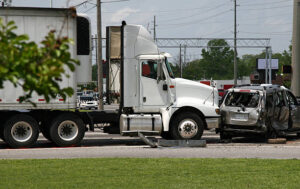The trucking industry was shocked recently when a jury awarded nearly a half-billion dollars to the plaintiffs in a case involving a 2019 crash. Two people died when their Volkswagen crashed into the rear of a 2004 Wabash dry van trailer.
The ruling cited the rear impact guard as defective — despite the fact that it met all legal safety requirements at the time the equipment was manufactured. In addition to $12 million in compensatory damages, the jury awarded $450 million in punitive damages.
Stunningly, what most would deem as crucial evidence — that the driver’s blood alcohol content was over the legal limit and that neither the driver nor the passenger of the Volkswagen were wearing seat belts — was withheld from the jury.
The plaintiffs’ attorneys were allowed to withhold this information because the suit was not against the motor carrier and truck driver; it was a product liability case against Wabash. The company and driver were not a part of the litigation at all.
Rising insurance costs
Earlier this year, the American Transportation Research Institute (ATRI) released an update to its “Analysis of the Operational Costs of Trucking,” which noted a 12.5% increase in trucking insurance premiums in 2023.
Some reasons cited for the increases were rising equipment costs, litigation and inflation. According to the report, some carriers reported further premium increases during the first quarter of 2024.
Protecting the company from both nuclear verdicts and rising insurance premiums is an issue for every carrier.
“It is clear that excessive jury verdicts have been permanently stamped on the litigation landscape,” said Jay Starrett, head of accident litigation for Scopelitis, Garvin, Light, Hanson & Feary, P.C. “Not only are excessive verdicts occurring routinely, but the number of jurisdictions reporting excessive verdicts continues to grow.”
Starrett spoke of judicial “hellholes” — jurisdictions where plaintiff’s attorneys are more likely to find sympathetic judges and juries.
“Unfortunately, reports of verdicts in the tens of millions of dollars are now routine, even in jurisdiction formerly considered conservative,” he said. “While the transportation defense bar is constantly developing new trial methods to counter excess verdicts, the reality is that we are fighting an uphill battle.”
Lewie Pugh, executive vice-president of the Owner-Operator Independent Drivers Association, says he’s noticed a troubling pattern in litigation against motor carriers and equipment manufacturers.
“They’ll try to prove a pattern of unsafeness whether it’s factual or not. We need tort reform,” Pugh said. “People need to be made whole (after an accident) but some of these awards go far beyond.”
Fighting for tort reform
The most obvious — as well as possibly the most difficult — solution is to limit the amount of compensation that can be awarded to plaintiffs, as well as to reduce the number of lawsuits filed.
“The most effective way to combat excessive verdicts — perhaps the only way — is through tort reform,” Starrett said.
Getting tort reform passed has turned out to be a large problem, however.
“Since every state establishes its own tort laws, tort reform must be accomplished on a state-by-state basis,” Starrett explained. “In today’s political climate, obtaining relief at the legislative level requires significant resources.”
The trucking industry ends up picking up the tab for most tort reform efforts … but carriers end up paying for both sides of the argument.
“The irony is not lost that the plaintiffs’ bar’s funding opposing tort reform is being paid for by transportation companies through multi-million dollar contingent fees they pocket from excessive verdicts,” Starrett said.
Just days after the Wabash verdict, an Alabama jury issued a $160 million award against Daimler Truck North America. The driver of a Western Star truck, manufactured by the company, was rendered a quadriplegic after a rollover crash.
Nearly half of the award — $75 million — was punitive.
The jury heard that Daimler had offered a different seat as an option in Freightliner and Western Star trucks which may have prevented the catastrophic injury to the driver. Since the company knew the seat was available but did not make it standard equipment, the jury ruled them responsible for the driver’s injuries.
“I’m blown away by some of the arguments that were not allowed in the Wabash case, from what I read,” explained Gary Johnson, head of safety and compliance strategy at Motive. “I mean, there are huge aspects that weren’t even allowed into the evidence.”
With the exception of small victories in a few states, real tort reform isn’t on the horizon. Carrier must be able to demonstrate their safety values beyond collision statistics.
Bring technology into the battle
Johnson is a firm believer in the use of driver technology to protect against unreasonable jury awards. For example, he says, dash cameras featuring artificial intelligence (AI) are a technology that works to record what actually happened during a crash event.
“In court, it’s pretty hard to argue when you have evidence right there,” he said.
Unfortunately, many fleets are not utilizing the available tech. A 2023 “State of Safety” report published by Motive surveyed 1,100 trucking and logistics companies and found that 40% of respondents said their fleets were underinvested in driver safety technology.
At the very least, integrating dash camera video recorders into a fleet can help in litigation. In addition, driver-facing cameras can help refute claims that a driver was distracted or fatigued at the time of an incident.
In addition, many camera systems can be set to alert the driver when certain potentially unsafe behaviors are recorded, helping reinforce safe driving behavior. Evidence that training has occurred, or hasn’t been needed, can be presented to strengthen a court case.
Pugh believes it’s a good idea for drivers to protect themselves using various means of documentation.
“To protect yourself, it’s a good thing,” he said. “Document, document, document everything.”
The argument used against Daimler — that a safer product was available but not used — can be used for any safety system.
Advanced Driver Assist Systems (ADAS) such as adaptive cruise control and collision mitigation are available, as are in-cab video systems. Carriers that decide not to use these safety features could possibly be judged as liable for any accidents or injuries they could have prevented.
Costs passed along to consumers
The cost of excessive financial awards in litigation is costly not only to the parties involved, but also to the general public.
“The industry is being devastated by nuclear verdicts, and society as a whole ultimately absorbs these verdicts through higher prices on goods,” Starrett said.
Real jobs are being lost and insurance rates are skyrocketing, if a carrier can even find an insurer,” he continued.
In addition, Johnson notes, exorbitant judgements against transportation companies are driving the size of the average award upward.
“FMCSA says the average the average cost of a general fatality is $1.7 million, but when you add the commercial motor vehicle equation into that, it’s $3.6 million,” Johnson explained. “It tells you right there that the industry is a target. Now you throw in these nuclear verdicts, and that’s just going to increase that average award.”
Cliff Abbott is an experienced commercial vehicle driver and owner-operator who still holds a CDL in his home state of Alabama. In nearly 40 years in trucking, he’s been an instructor and trainer and has managed safety and recruiting operations for several carriers. Having never lost his love of the road, Cliff has written a book and hundreds of songs and has been writing for The Trucker for more than a decade.









When it coms to the driver seat I don’t know how the manufacturer is liable for a seat should have been removed out of service or made obsolete from the manufacturer of the seat and where’s the standard for the company …..that means safety when designing the seat… That’s an endless lawsuit and everything has to be a Mercedes or Ferrari in designer choice… And the inferior seat must then print it out that there’s better seats out there or has an inherit design….. I think they’re just looking for who has the most money and let’s sue him
When it comes to these verdicts they might be right… For the first time in 30 years of driving the reason why sleepers don’t come with a toilet is because they want to make money on the rest stops “”what does that have to do with this?””drivers are being used and victimized in a slave trade of Labor there is no shortage of drivers they just want to make it a surplus of drivers so that they can bid down driver pay…. We have technology today that literally can be posted on a camera on the truck and look at all the people that cut a tractor trailer or commercial vehicle I didn’t unsafe speed causing us to panic at times beyond our imagination that it’s actually true and this famous brake check I believe it can all stop to education…. Start penalizing drivers that cut commercial trucks are by sending an email to the insurance company and let the insurance company collect that data and penalize insurance policy of those drivers at the same time giving a discount to the drivers I’m their insurance for everyone that cuts them off prematurely…. It’s a win-win situation people are curbed bad habits and drivers get rewarded for following safety guidelines I believe all we need is a 25 cents to make my point…. CommercialDrivers lives matter…